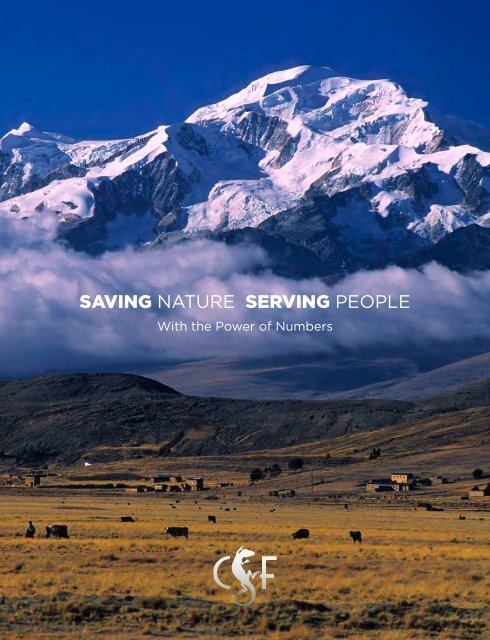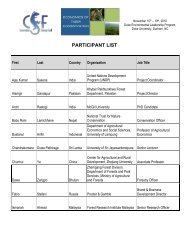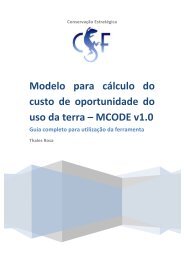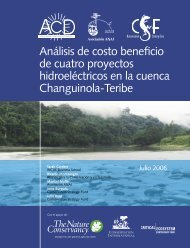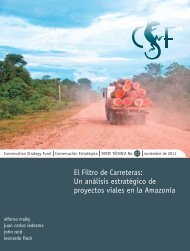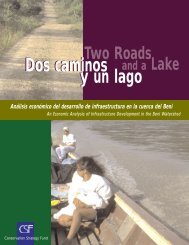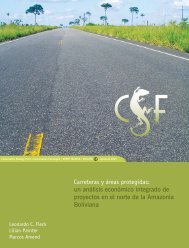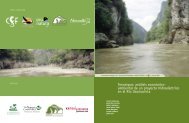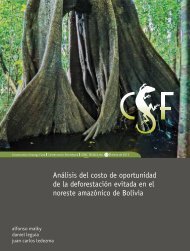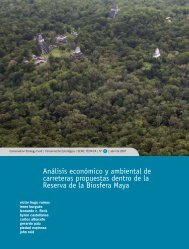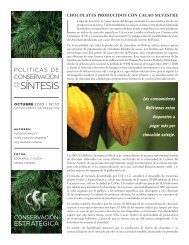Download (1.73 MB) - Conservation Strategy Fund
Download (1.73 MB) - Conservation Strategy Fund
Download (1.73 MB) - Conservation Strategy Fund
Create successful ePaper yourself
Turn your PDF publications into a flip-book with our unique Google optimized e-Paper software.
SAVING NATURE SERVING PEOPLE<br />
With the Power of Numbers
OUR VISION<br />
We can have prosperous economies and a<br />
living planet. Healthy forests, rivers and<br />
oceans can coexist with the needs of people.<br />
In fact, achieving this balance is more urgent<br />
than ever. But to get there we need to forge<br />
the smartest, most economically realistic<br />
strategies for conservation. That is what<br />
<strong>Conservation</strong> <strong>Strategy</strong> <strong>Fund</strong> does. Founded<br />
in 1998, CSF helps local environmentalists<br />
around the world use economics to show the<br />
value of nature, avoid senseless destruction<br />
of resources, and share nature’s benefits<br />
more equitably. We do it with a unique<br />
combination of dynamic economics training<br />
and applied field studies.<br />
All of our achievements, including the<br />
highlights listed on this timeline, have been<br />
made possible by the hard work of our<br />
many partners, alumni and friends, who are<br />
too numerous to mention here. We salute<br />
all of you!<br />
1998<br />
FOUNDING<br />
1 st CSF course<br />
delivered, with<br />
Smithsonian.<br />
CSF’s Bala dam<br />
analysis helps<br />
save 741,000<br />
acres of<br />
Bolivian jungle<br />
from flooding.<br />
CSF shows that<br />
Chalillo dam in<br />
Belize would<br />
raise electricity<br />
rates, contrary<br />
to government<br />
claims. Project<br />
slowed but<br />
eventually built<br />
– and raises<br />
rates!<br />
CSF shows that<br />
indigenous<br />
Peruvians in<br />
a roadless area<br />
have higher<br />
incomes than<br />
those living<br />
on rainforest<br />
roads. Study<br />
contributes to<br />
creation of<br />
988,000 acre<br />
Amarakaeri<br />
Communal<br />
Reserve.<br />
CSF study in<br />
Jalapao region<br />
of Brazil leads<br />
to creation of<br />
1.7 million acre<br />
park.<br />
CSF study<br />
contributes to<br />
redesign of<br />
Panama Canal<br />
expansion,<br />
saving 123,000<br />
acres from<br />
flooding, and<br />
allowing<br />
10,000 people<br />
to stay in their<br />
rural homes.<br />
CSF study<br />
in Equatorial<br />
Guinea argues<br />
for ban on<br />
monkey hunting,<br />
eventually<br />
enacted,<br />
protecting<br />
seven endemic<br />
species of<br />
monkeys.<br />
Brazil office<br />
opens<br />
1st Africa<br />
course, in<br />
Madagascar<br />
CSF research<br />
helps re-route<br />
road around<br />
Volcán Barú<br />
National Park<br />
in Panama,<br />
protecting<br />
34,000<br />
acres of cloud<br />
forest, habitat<br />
of a rare<br />
bird, the<br />
respendent<br />
quetzal.<br />
CSF launches<br />
training<br />
partnership<br />
with Stanford<br />
University.<br />
CSF study<br />
results in<br />
Tanzanian<br />
National Park<br />
system changing<br />
fees to<br />
lessen crowding<br />
and increase<br />
income.<br />
Bolivia office<br />
opens<br />
1 st Mesoamerica<br />
course, in Costa<br />
Rica<br />
CSF shows<br />
deforestation,<br />
fire and<br />
economic<br />
losses would<br />
result from<br />
new roads<br />
in Central<br />
America’s<br />
Maya Forest,<br />
saving 92,000<br />
acres.<br />
CSF shows that<br />
dams in<br />
Panama’s Bocas<br />
del Toro<br />
province place<br />
heavy environmental<br />
cost<br />
on Naso and<br />
Ngobe Indians,<br />
empowering<br />
communities<br />
in their<br />
negotiations.<br />
CSF finds<br />
that proposed<br />
Tenosique<br />
dam, which<br />
would have<br />
inundated<br />
several important<br />
archaeological<br />
sites<br />
would be<br />
dependent<br />
on wasteful<br />
subsidies.<br />
River remains<br />
undammed.<br />
CSF shows<br />
that<br />
11,000-megawatt<br />
Belo<br />
Monte dam in<br />
Brazil would<br />
make larger<br />
dams in the<br />
Xingu Basin<br />
nearly<br />
inevitable.<br />
Construction<br />
delayed,<br />
protecting over<br />
100,000 acres.<br />
La Paz governor<br />
cancels support<br />
for roads in<br />
Bolivia’s Madidi<br />
National Park<br />
after learning<br />
from CSF that<br />
construction<br />
would lose<br />
millions<br />
economically.<br />
45,000 acres<br />
saved.<br />
CSF launches<br />
Marine Program.<br />
CSF shows how<br />
payments for<br />
water could<br />
finance indefinite<br />
protection<br />
of Tres Picos<br />
State Park in<br />
Rio de Janeiro,<br />
Brazil.<br />
10 th<br />
International<br />
Course held at<br />
Stanford.<br />
Study of BR-319<br />
road in Brazilian<br />
Amazon shows<br />
that it would<br />
squander<br />
US$200 million<br />
and cause<br />
heavy deforestation<br />
and<br />
carbon emissions,<br />
resulting<br />
in delay of road<br />
construction.<br />
1999 2000 2001 2002 2003<br />
2004 2005 2006 2007 2008<br />
All images by and courtesy of Marcos Amend,<br />
Tom Dey, Leonardo Fleck, and John Reid.<br />
Graphic design courtesy of LSMD.<br />
This publication was set in H&FJ Gotham<br />
and printed by Clear Image Printing on paper that is 100%<br />
recycled, 50% post-consumer waste with chlorine free inks.<br />
© 2009 <strong>Conservation</strong> <strong>Strategy</strong> <strong>Fund</strong>
TRAINING + ANALYSIS =<br />
1.7 MILLION ACRES<br />
SAVED<br />
Imagine a place where crystal clear rivers lap at<br />
sand dunes. Rare flowers sprout from a desert full<br />
of water. And people weave wires of golden grass<br />
into exquisite baskets. This is the Jalapão, a part of<br />
Brazil where two great ecosystems—Cerrado and<br />
Caatinga—overlap and create a third one full of<br />
unique life. Three students in CSF’s first course in<br />
Brazil, Wilson Cabral de Sousa Junior, Fani<br />
Mamede and Paulo Garcia, joined with CSF and<br />
<strong>Conservation</strong> International in a study of the<br />
Jalapão, which was threatened by a massive water<br />
diversion scheme. They discovered its financial<br />
losses would be enormous, which helped government<br />
officials decide to set aside 1.7 million acres<br />
for permanent protection.<br />
Wilson Cabral de Sousa Junior<br />
Instituto Tecnológico de Aeronáutica, Brazil<br />
“Without CSF, it is likely that the Jalapao<br />
would have been destroyed.”<br />
CONSERVATION STRATEGY FUND 10 Year Report 2009<br />
5
BUILDING A<br />
BETTER ROAD<br />
A trail wanders along the slope of Panama’s Volcan<br />
Baru, through cloud forest, along the Caldera River<br />
and under the nests of resplendent quetzals.<br />
Quetzals are outlandish birds: shimmering emerald,<br />
scarlet and white, crowned with yellow fuzz, and<br />
finished with a dangling tail feather three times<br />
the length of their bodies. Namesake of the currency<br />
of Guatemala, they also give their name to<br />
Panama’s best known hiking trail.<br />
In 2002 a plan surfaced to pave the trail and bring<br />
cars though the heart of its’ surrounding national<br />
parkland. CSF and The Nature Conservancy<br />
analyzed the proposal at the invitation of locals<br />
opposed to the project. We found that there was a<br />
better alternative to the optimistically named<br />
“eco-road,” which would lose nearly a million<br />
dollars in addition to severing Volcán Barú from<br />
neighboring habitat. This alternative, around the<br />
other side of the volcano through productive<br />
agricultural land, was eventually selected based<br />
on local demands and the economic evidence.<br />
Mayté González<br />
CSF Course Graduate<br />
The Nature Conservancy, Panama Director<br />
“Thanks to the CSF course, I came to<br />
realize that when we are talking about<br />
development, we have to include the<br />
financial and economic dimension. Now<br />
we have this additional tool, which is<br />
economic analysis, and it’s great”<br />
CONSERVATION STRATEGY FUND 10 Year Report 2009<br />
7
Land<br />
Over 3.8 million acres saved. = 15,378 km2<br />
This area is larger than the US State of Connecticut.<br />
The breakdown:<br />
Place<br />
Acres<br />
Madidi (Bala), Bolivia 741,300<br />
Amarakaeri, Peru 988,400<br />
Jalapao, Brazil 1,729,700<br />
Panama Canal, Panama 123,550<br />
Volcan Baru, Panama 34,594<br />
Maya Forest, Mexico, Belize, Guatemala 92,000<br />
Belo Monte, Brazil 108,724<br />
CSF has achieved big results on a modest<br />
budget, whether measured in terms of acres saved,<br />
people served, animal species preserved, or<br />
carbon sequestered.<br />
3,818,268<br />
Carbon<br />
By helping conserve land, CSF has played a key role in<br />
preventing 550 million tons of CO2 from being released<br />
into the atmosphere. That is equivalent to the annual<br />
emissions of 22 coal fired power plants.<br />
BIG RESULTS FOR<br />
NATURE<br />
CONSERVATION STRATEGY FUND 10 Year Report 2009<br />
9
We are driven to focus on the human side of<br />
conservation. We want to know who benefits and<br />
how much. Where does conservation have the<br />
biggest payoff for people Our work has paid off<br />
for the more than 900 people from 70 countries<br />
who have participated in CSF courses, and for the<br />
millions of people in their home countries who<br />
have benefited from their environmental efforts.<br />
Our field studies benefit indigenous people<br />
struggling to assert their resource rights, communities<br />
looking for economic alternatives that will<br />
actually work, city dwellers who simply care about<br />
nature and many others.<br />
One of our earliest collaborations, with the Center<br />
for Popular Legal Assistance in Panama, analyzed<br />
a proposed expansion of the Panama Canal, and<br />
was one factor that led to consideration and<br />
eventual approval of a much lower-impact plan,<br />
now being constructed. That choice will dramatically<br />
reduce flooding and allow over 10,000 people<br />
to keep their small farms.<br />
SERVING PEOPLE<br />
SAVING SPECIES<br />
Conserving terrestrial and marine ecosystems<br />
is about much more than raw acres of forest, or<br />
square miles of reef. Every stretch of land or ocean<br />
that is saved is home to a dazzling diversity of<br />
plants and animals.<br />
We’d love to list the thousands of species<br />
whose survival has been aided by our work, but<br />
space is limited so we’ll just name a few.<br />
Scarlet macaw<br />
Belize, Guatemala and Mexico<br />
7 species of monkeys<br />
Bioko Island, Equatorial Guinea<br />
Giant otters and tapirs<br />
Amazon and Pantanal, Brazil and Bolivia<br />
Woolly spider monkey<br />
Atlantic Forest, Brazil<br />
Resplendent quetzal<br />
Panama, Guatemala<br />
Brazililan merganser duck<br />
Jalapão, Brazil<br />
Whale shark<br />
Mesoamerican reef, Belize<br />
CONSERVATION STRATEGY FUND 10 Year Report 2009<br />
11
THE FUTURE<br />
SAVING NATURE<br />
CAN BE A<br />
LOW COST<br />
PROPOSITION<br />
From just an idea, CSF has now grown to a staff<br />
of 15 staff in three countries on two continents.<br />
But much remains to be done. As our approach<br />
has begun to take hold throughout the conservation<br />
world, we see more and more demand.<br />
Here’s a few things we’ll do with more resources:<br />
Increase our training capacity. Currently we receive<br />
over 10 applications for every available training<br />
position—more classes in more places are urgently<br />
needed; Work in more critical regions such as<br />
Central America, Southeast Asia and Africa; And<br />
address more of humanity’s pressing challenges,<br />
like climate change and the health of<br />
our oceans.<br />
CSF has proven that enhancing the capacity of<br />
decision-makers worldwide to differentiate good<br />
projects from bad can achieve impressive results<br />
at a remarkably low cost.<br />
Total acres saved: 3.8 million<br />
Total 10-year expenditures: $5.5 million<br />
Cost per acre:
STAFF AND BOARD SUPPORTERS 1998–2009<br />
STAFF & FELLOWS<br />
Alfonso Malky<br />
Research Analyst, Bolivia<br />
Carol Fernandez<br />
Administrative Assistant, Bolivia<br />
Cecilia Ayala<br />
Program Director, Bolivia<br />
Courtney Lewis-Cheng<br />
Administrative Assistant, USA<br />
Cristian Vallejos<br />
Program Director for Latin America<br />
Cynthia Bomtempo Franco<br />
Financial Manager, Brazil<br />
Denise Helena França Marques<br />
Economic Analyst, Brazil<br />
Doron Amiran<br />
Development Director, USA<br />
Holly Busse<br />
Director of Finance and Administration, USA<br />
John Reid<br />
President and Founder, USA<br />
Kim Bonine<br />
Training Director, USA<br />
Leonardo Fleck<br />
Senior Economic Analyst, Brazil<br />
Marcos Amend<br />
Executive Director, Brazil<br />
Monica Rocha<br />
Administrative Assistant, Brazil<br />
Sophia Espinoza Kantuta<br />
Amazon Economic Research Fellow, Bolivia<br />
Venetia Hargreaves-Allen<br />
Research Fellow, Bahamas<br />
US BOARD<br />
Bob Hambrecht (Treasurer)<br />
Environmental Finance Consultant<br />
San Francisco, CA<br />
Linwood Pendleton<br />
Director of Ocean and Coastal Policy<br />
Nicholas Institute for Environmental Policy<br />
Solutions at Duke University<br />
Durham, NC<br />
John Reid<br />
President, <strong>Conservation</strong> <strong>Strategy</strong> <strong>Fund</strong><br />
Sebastopol, CA<br />
Peter Rogers<br />
Founder, Dry Creek Ventures<br />
Healdsburg, CA<br />
Stewart Wakeling (Chair)<br />
Project Director/Principal Investigator<br />
Safe Community Partnership<br />
Public Health Institute<br />
Oakland, CA<br />
William White<br />
Senior Vice President, David Gardiner<br />
and Associates<br />
Marshfield, MA<br />
BRAZIL BOARD<br />
Carlos Alberto Mesquita<br />
Instituto BioAtlântico<br />
João Carlos Pádua<br />
Institute for Socio-environmental Studies in<br />
Southern Bahia<br />
John Reid<br />
<strong>Conservation</strong> <strong>Strategy</strong> <strong>Fund</strong><br />
Marcelo Araújo (President)<br />
Institute for Socio-environmental studies in<br />
Southern Bahia<br />
Maria José Gontijo<br />
International Institute for Education in Brazil<br />
Nurit Bensusan<br />
International Institute for Education in Brazil<br />
Thanks to the following foundations<br />
and institutions for supporting CSF:<br />
Acer <strong>Fund</strong><br />
Baker and McKenzie<br />
Bank of America<br />
Blue Moon <strong>Fund</strong><br />
Boston Foundation<br />
Charles Stewart Mott Foundation<br />
<strong>Conservation</strong> International<br />
Critical Ecosystem Partnership <strong>Fund</strong><br />
eBay Foundation<br />
Evelyn and Walter Haas, Jr. <strong>Fund</strong><br />
Falik Family <strong>Fund</strong><br />
Firedoll Foundation<br />
Gifts In Kind International<br />
Global <strong>Conservation</strong> <strong>Fund</strong><br />
Gordon and Betty Moore Foundation<br />
Instituto Internacional de Educacao do Brasil<br />
John D. and Catherine T. MacArthur<br />
Foundation<br />
Larry L. Hillblom Foundation<br />
Macromedia<br />
Moriah <strong>Fund</strong><br />
Marin Community Foundation<br />
Mott Foundation<br />
Oracle Corporation<br />
Penney Family <strong>Fund</strong><br />
Richard and Rhoda Goldman <strong>Fund</strong><br />
Rockwood Foundation<br />
San Francisco Foundation<br />
Schwab Charitable <strong>Fund</strong><br />
Sonoma County Community Foundation<br />
State University of New York<br />
Summit Foundation<br />
Tarbell Foundation<br />
The Nature Conservancy<br />
United Way<br />
US Agency for International Development<br />
W. Alton Jones Foundation<br />
Wildlife <strong>Conservation</strong> Society<br />
World Bank Institute<br />
World Wildlife <strong>Fund</strong><br />
Thanks also to our major individual donors<br />
($2500 and above):<br />
Adam Diamant<br />
Andre Carothers<br />
Bob and Elissa Hambrecht<br />
Ching Wang<br />
Dan D. Smith and Joan Marler-Smith <strong>Fund</strong><br />
Deborah Moore and Adam Dawson<br />
Frank and Brinna Sands<br />
Fred Cannon and Jeanne Mitchell<br />
Gail and Dick Odgers<br />
Ken and Helen Noble<br />
Kevin Knowles<br />
Lew and Mary Reid<br />
Lisa Clyde-Garcia<br />
Loretta Keller<br />
Peggy Reid<br />
Peter Rogers and Melita Love<br />
Quincey Tompkins Imhoff<br />
Robert and Susan Leberman<br />
Stewart and Laura Wakeling<br />
Susan Reid<br />
Tom Dey<br />
William and Shirley Andrews<br />
to our hundreds of other individual donors—<br />
thank you!<br />
Jason Cole<br />
Senior Program<br />
Officer<br />
Gordon and<br />
Betty Moore<br />
Foundation<br />
“CSF is recognized<br />
not only as<br />
a great training<br />
organization,<br />
but also as an<br />
honest, objective<br />
and very<br />
competent<br />
analytical team.<br />
We are seeing<br />
their work<br />
directly influencing<br />
key<br />
decisionmakers.”<br />
CONSERVATION STRATEGY FUND 10 Year Report 2009<br />
15
103 Morris Street, Suite S<br />
Sebastopol, CA 95472<br />
T: 707.829.1802<br />
F: 707.829.1806<br />
1160 G Street, Suite A-1<br />
Arcata, CA 95521<br />
T: 707.822.5505<br />
F: 707.822.5535<br />
Rua Professor Cândido Almeida, No. 143,<br />
Bairo Joana D’Arc, Lagoa Santa<br />
CEP 33400-000. MG, Brazil<br />
T/F: +55.31.3681.4901<br />
Av. Sanchez Lima 2600, Piso 702<br />
Casilla: 4945 La Paz, Bolivia<br />
T/F: +591.2.243.1038<br />
www.conservation-strategy.org


